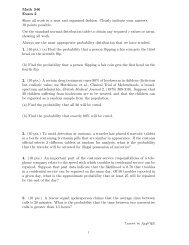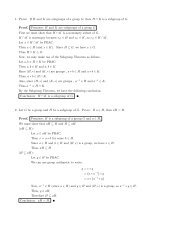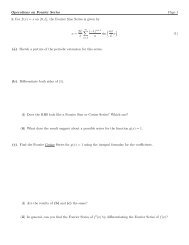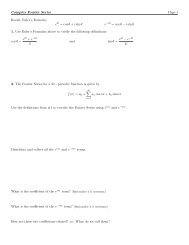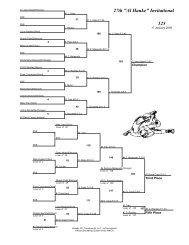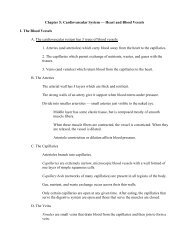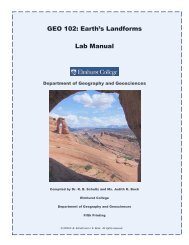Free Executive Summary - Elmhurst College
Free Executive Summary - Elmhurst College
Free Executive Summary - Elmhurst College
You also want an ePaper? Increase the reach of your titles
YUMPU automatically turns print PDFs into web optimized ePapers that Google loves.
Learning to Think Spatially: GIS as a Support System in the K-12 Curriculum<br />
http://www.nap.edu/catalog/11019.html<br />
SPATIAL THINKING IN EVERYDAY LIFE, AT WORK, AND IN SCIENCE 53<br />
normal, everyday cognitive processing; the novice-expert difference is a consequence of the degree<br />
and type of practice and experience in a domain.<br />
Getting to work is not the only spatial task shared by different occupations. In order to operate,<br />
workers need a mental model of the structure and functioning of the institution: they need to know<br />
who to turn to for help on what task. Sometimes information is mentally represented as a spatial<br />
network, much like a rudimentary mental map of an environment. In this institutional mental space,<br />
links are tasks and nodes are people who perform tasks. Often information is explicitly represented<br />
in an organizational chart and depicted as a spatial network that must be “navigated.” Managers<br />
must decide how to allocate resources or what new projects to undertake. To do so, they consult<br />
charts and graphs of performance. Charts and graphs provide spatial representations of data, but do<br />
not in themselves provide solutions to problems. Solutions depend on making inferences from<br />
charts and graphs, projections of future sales, changes in personnel and equipment, and more.<br />
Beyond generic problem-solving similarities, many jobs require the use of specific spatial<br />
skills. Recognition of complex patterns is required in many professions. Think of the time you saw<br />
an X-ray image in a doctor’s office. You could probably pick out bones but little else. In the clouds<br />
that X-rays resemble, highly trained radiologists can discern tumors, blood clots, and faulty valves.<br />
Recognizing these patterns takes years of training and is by no means perfect (see Ericsson, 1996,<br />
for an overview of the literature on expertise; see the November 2003 issue of the Educational<br />
Researcher on expertise in the context of education).<br />
Recognition skill does not transfer to other domains. Skilled radiologists are no better than<br />
novices at recognizing skin diseases that dermatologists are expert in diagnosing or plant diseases<br />
that botanists excel at discerning. Expertise in pattern recognition is domain specific. It requires<br />
discerning features characteristic of specific sensory categories. Typically, domain expertise in<br />
pattern recognition also requires learning the proper configurations of distinctive features. The<br />
practice that polishes this skill requires categorizing many examples of related and different phenomena<br />
and getting feedback on the categorization process. Simply seeing examples is not sufficient;<br />
to become expert, people must learn to differentiate and discriminate one category from<br />
another (Nickerson and Adams, 1979). A classroom demonstration illustrates that seeing, however<br />
frequent, is insufficient to ensure learning critical features. Students are asked to name what is<br />
shown on both sides of a penny or whether their (analog) watch dial has lines or numbers to mark<br />
minutes. Few succeed at the penny task, and many are surprisingly poor at the watch task. Although<br />
we “look” at pennies and watches frequently, often many times a day, we do not have to distinguish<br />
one penny or watch face from another (Nickerson and Adams, 1979). We do, however, need to<br />
distinguish a penny from a nickel or dime, and we do so based on color or shape or size without<br />
paying attention to the face of the coin. In watches, we only consult the lengths of hands and their<br />
angles. When we need to make fine distinctions, such as those required to differentiating types of<br />
tumors or diagnosing skin diseases, we must learn the fine details distinguishing among tumors or<br />
skin diseases.<br />
Pattern recognition, then, is a spatial skill demanded by many disciplines. People learn to<br />
distinguish critical features in their proper, two-dimensional spatial configurations. Other professions,<br />
however, require skill in thinking about three-dimensional configurations, a process especially<br />
difficult for the human mind. Although the physical world is (at least) three dimensional, the<br />
image captured on the retina and represented topographically in visual areas of the cortex is two<br />
dimensional. Thus, the three-dimensional world is a mental construct built from numerous cues to<br />
depth as well as experience navigating the world. Experience teaches us how to integrate twodimensional<br />
views into three-dimensional representations. Integration of two-dimensional views<br />
can be accomplished by means of features, objects, and landmarks common to different views.<br />
Integration of two-dimensional views is also accomplished by means of a frame of reference that is<br />
Copyright © National Academy of Sciences. All rights reserved.



